Using Morphology to Teach Vocabulary

A recent blog post by Tim Shanahan titled “What should morphology instruction look like?” reminded me how important it is to teach students about word parts (i.e., roots, prefixes, suffixes) as a useful tool for determining the meaning of unfamiliar words and growing academic vocabularies.
One of the five components of our Key Vocabulary Routine is Teach Word Learning Strategies, which includes how to look for clues outside the word (use of context) and inside the word (use of word parts) when encountering an unknown word while reading. Outside clues include rereading the sentences before and after the word and using the context of the text. Inside clues come from recognizing meaningful parts of the word, i.e., using morphological knowledge.
Morphemes and Morphological Awareness
Morphemes are the smallest units of meaning in a language. The dictionary defines a morpheme as “a word or part of a word that has a meaning and that contains no smaller part that has a meaning.” Morphemes include base words and roots, prefixes, and suffixes. They can be combined in different ways to express particular meaning or to fill grammatical roles. Some morphemes are free – they can stand alone (e.g., cat, walk, govern). Other morphemes are bound – they cannot stand alone and must be attached to another morpheme (e.g., re-, un-, geo, phon, -ed, -ment). Here are some examples:
- The word cat contains one free morpheme
- The word cats contains one free morpheme (cat) and one bound morphemes (s)
- The compound word sandbox contains two free morphemes (sand, box)
- The word unfit contains one bound morpheme (un) and one free morpheme (fit)
- The word transportable contains three bound morphemes (trans, port, able)
Morphology means the study of word parts, and morphological awareness refers to the ability to recognize the presence of morphemes in words. Research suggests that students can be taught various morphemic elements as a way to determine the meaning of new words (Edwards et al., 2004). Carlisle (2010) analyzed 16 studies about the relation of morphological awareness instruction to key components of literacy development. The findings showed that instruction about word parts was associated with improvements in word reading and spelling, and in determining the meaning of unfamiliar words.
Academic, School Morphemes
Academic vocabulary that must be learned beyond grade three often consists of words that combine a root, prefix, and suffix (e.g., poly + nom + ial = polynomial; manu + script = manuscript). In the upper elementary grades and higher, there are many opportunities to find words in content reading that contain Greek and Latin morphemes. Children in primary grades can begin to learn how morphemes combine by adding common prefixes and suffixes to short Anglo-Saxon words and also compounding them. For example:
- jump, jumps, jumped, jumping, jumper
- read, reread, reader, nonreader, reading
- sunshine, schoolhouse, upstream
There are some limitations to morphemic analysis. Although it is useful, teachers must also make students aware that it doesn’t always work. This is because some prefixes are not consistent in meaning (e.g., in- means both not and in). It is also because the meaning of many Greek and Latin roots have changed substantially over hundreds of years, so they no longer lend themselves to literal translation. For example, the literal translation of circumspect should be look around (circum means around, spect means look), while the real meaning is to be cautious, careful.
Introducing Morphology
One way to introduce word analysis skills is to teach students how words are made up of word parts, and how words can be related in word families, such as the word family below for the Latin root port (to carry).
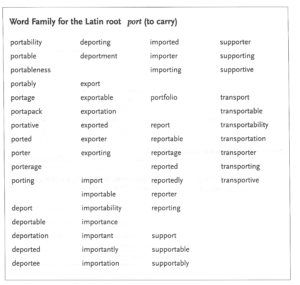
Keys to Literacy trainers often see examples of teachers using word families when we visit classrooms. Here are some examples:
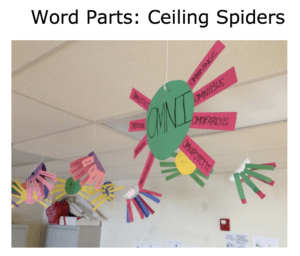
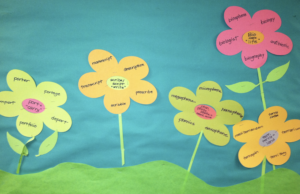
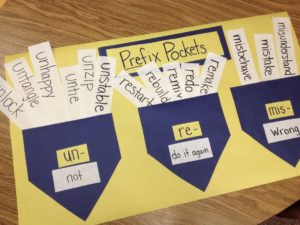
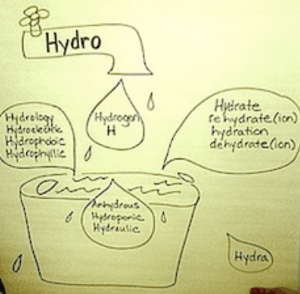
Another instructional strategy is to have students build word families by providing a main root and then prefixes and suffixes that can be combined with the root to generate words. Word Matrix boxes such as the examples below can be used for this purpose. For more examples, visit Peter Bowers’ website Word Works.
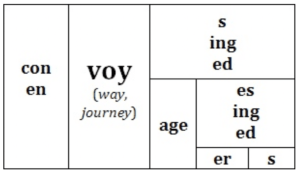
convoy, envoy, convoys, envoys, convoying, convoyed, voyage, voyages, voyaging, voyaged, voyager, voyagers

retake, retakes, retaken, retaking, untaken, mistake, mistakes, mistakable, mistakably, mistaken, mistakenly, mistaking, intake, intakes, overtake, overtakes, overtaken, overtaking, undertake, undertakes, undertaker, undertaken, undertaking, undertakings, uptake, uptakes, breathtaking, caretaker, caretaking, takes, taker, taken, taking, takeaway, takeover
Teaching Morphology
Here are two additional suggestions from our Key Vocabulary Routine professional development program:
- Find opportunistic moments: Often, unplanned moments come up during content instruction to provide examples of word analysis. Words from content vocabulary lists may include common word parts, or an opportunity to make a connection between the root of a new word and a word previously covered in class may arise. Content teachers in particular are in a position to point out examples of words that contain roots, prefixes, and suffixes from content reading material.
- School-wide focus: Most of the general academic words that students need to learn are derived words with word parts. A school-wide approach to teaching academic vocabulary involves teachers from different grades and subjects agreeing to focus on a few root words and their associated word families each week or two.
A 2015 piece posted by the Institute for Multi-Sensory Education’s blog suggests these strategies for teaching morphology in the classroom based on research by Dr. Nonie Lesaux:
- Morphology should be taught as a distinct component of a vocabulary improvement program throughout the upper elementary years.
- Morphology should be taught as a cognitive strategy to be learned. In order to break a word down into morphemes, students must complete the following four steps:
- Recognize that they don’t know the word.
- Analyze the word for recognizable morphemes, both in the roots and suffixes.
- Think of a possible meaning based upon the parts of the word.
- Check the meaning of the word against the context.
- Students also need to understand the use of prefixes, suffixes, and roots, and how words get transformed.
Lists of Roots, Prefixes, Suffixes
There is a significant body of research indicating that instruction of prefixes is beneficial, and many vocabulary researchers recommend instruction of the most common prefixes as the first and best component of word analysis (Graves, 2004; Carlisle, 2007). White, Sowell, and Yanagihara (1989) found that 20 prefixes account for almost 97% of the 2,959 prefixed words that most frequently appear in school reading materials. Given how often these 20 prefixes occur, it makes sense to teach their meaning and use. To access a free list of these prefixes, visit the Keys to Literacy free resources page at our website, and go to the Vocabulary section. You will also find free lists of the following:
- Common Numerical Prefixes
- Common and Useful Suffixes
- Common Greek and Latin Roots
References:
Carlisle, J.F. (2010). Effects of instruction on morphological awareness on literacy achievement: An integrative review. Reading Research Quarterly, 45 (4) 464-487.
Carlisle, J.F. (2007). Fostering morphological processing, vocabulary development, and reading comprehension. In R.K. Wagner, A.E., Muse, & K.R. Tannenbaum (Eds.). Vocabulary acquisition: Implications for reading comprehension. New York: Guilford Press.
Edwards, C.E., Font, G., Baumann, J.F., & Boland, E. (2004). Unlocking word meanings: Strategies and guidelines for teaching morphemic and contextual analysis. In James, R. Baumann & Edward J. Kame/ennui (Eds.). Vocabulary instruction: Research to practice. New York: Guilford Press.
Graves, M.F. (2004). Teaching prefixes: As good as it gets? In James, R. Baumann & Edward J. Kame/ennui (Eds.). Vocabulary instruction: Research to practice. New York: Guilford Press.
White, T.G., Sowell, J., & Yanagihara, A. (1989). Teaching elementary students to use word-part clues. The Reading Teacher, 42.

 Joan Sedita is the founder of Keys to Literacy and author of the Keys to Literacy professional development programs. She is an experienced educator, nationally recognized speaker and teacher trainer. She has worked for over 35 years in the literacy education field and has presented to thousands of teachers and related professionals at schools, colleges, clinics, and professional conferences.
Joan Sedita is the founder of Keys to Literacy and author of the Keys to Literacy professional development programs. She is an experienced educator, nationally recognized speaker and teacher trainer. She has worked for over 35 years in the literacy education field and has presented to thousands of teachers and related professionals at schools, colleges, clinics, and professional conferences.
Thank you so much for this awesome blog reminding us once again that vocabulary instruction can/ should be engaging! Not looking up words in a dictionary-silently! Using reading research to guide classroom practice- priceless!!
Thanks for the information! You are a kind, generous and well-informed soul. Keep up the good work!
Thanks Michael!
GREAT INFORMATIONAL BLOG! I teach gifted students who typically have a huge vocabulary and I use the techniques you outlined to help them interpret a meaning to the word! Many times my students can say the word but not understand the meaning. That’s when we use morphology; both outside the word and inside the word to make meaning of the word they are focusing on!
Thank you for your excellent advice on how to teach spelling. I an homeschooling my 7year old because of the covid19 lockdown and I had no idea where to start teaching her. However I knew rout learning was not going to work for her. I will look for activities that have this technique to teach her.
This is really useful information. It makes so much sense in relation to trying to understand meaning from the context.
Amazing work…… Ms Sedita……. Tons of hardwork i can see in ur effforts.
Thank you so much for such this informative blog. I now have a clearer understanding of using morphology to teach vocabulary.
Thanks for such an amazing blog. It was very beneficial to me.
such a nice article. Thank you
I enjoyed reading this article and am looking forward to checking out your free resources as well as Peter Bowers’ Word Works.
Thank you so much for organizing and providing this quality information
This is a great inspiring article.
Really thankful for your article, I’m 75 years old and wish I would have read this 50 years ago. I’m studying Hebrew and can see I have my hands full but loving it.
VERY informative
I have a much better understanding for teaching vocabulary.
Great article – thank you. One question: You wrote, “The word transportable contains three bound morphemes (trans, port, able).” Aren’t ‘port’ and ‘able’ free, given that they can stand alone? I may be mistaken. Thanks for clarifying.
Hello, I have browsed most of your posts. This post is probably where I got the most useful information for my research. Thanks for posting, maybe we can see more on this.
What would this look like in kindergarten?
Young children in K and grade 1 are not developmentally ready to read long, multisyllable words that are derived from Latin or Greek. However, they can be introduced to some very basic suffixes such as plural s or past tense ed.
Thank you! Super resource for morphemes / morphology. Will be using these activities this summer with rising fifth graders.
I do not know of a core program just for teaching vocabulary at each grade level. I understand why you would prefer something with lessons already mapped out with specific words to teach. However, effective vocabulary instruction should focus on words that are related to and essential to the content you are teaching, found in the text you are using. Morphology is just one part of vocabulary instruction. You may find helpful this recorded, free webinar from Keys to Literacy: Effective Vocabulary Instruction https://vimeo.com/42216838
I really love to read such an excellent article. Helpful article
Thanks so much for the post.Thanks Again. Keep writing.
Thank you for sharing such informative and innovative ideas! Keep up the fantastic work, and remember, we’re here to support your efforts!
Thanks for this great blog that reminds us once more that vocabulary teaching can and should be engaging! Not checking words in a dictionary—without speaking! Utilizing reading research to inform classroom practice is invaluable!
That is very helpful, thank you so much for creating a bog like it.